 |
|||||
|
|||||
| Preview of Stamps Catalogue: VOLUME 1 |
 |
|||||
|
|||||
| Preview of Stamps Catalogue: VOLUME 1 |
Return To Catalogue - Other German States - Germany - Goldner
Note: on my website many of the
pictures can not be seen! They are of course present in the catalogue;
contact me if you want to purchase it.
Considered as one of the German States that issued stamps. Heligoland is an island situated in the North Sea, it was formerly a British possesion from 1814-1890. It was then ceded to Germany in exchange for East Africa Territory, all stamps of Heligoland became invalid in 1890.
More information on reprints can be found at: http://www.geocities.com/Hollywood/Hills/9744/HELIGO.HTM and 'Originale und Neudrucke von Helgoland' by Arthur Wulbern Hamburg (in German, I haven't read this book myself). Also very useful information can be found at: http://www.fritzwagner.com/helgoland/robert_pollard_heligoland.html and http://www.qn.net/~fjw/helgoland/helgoland_forgeries.html.

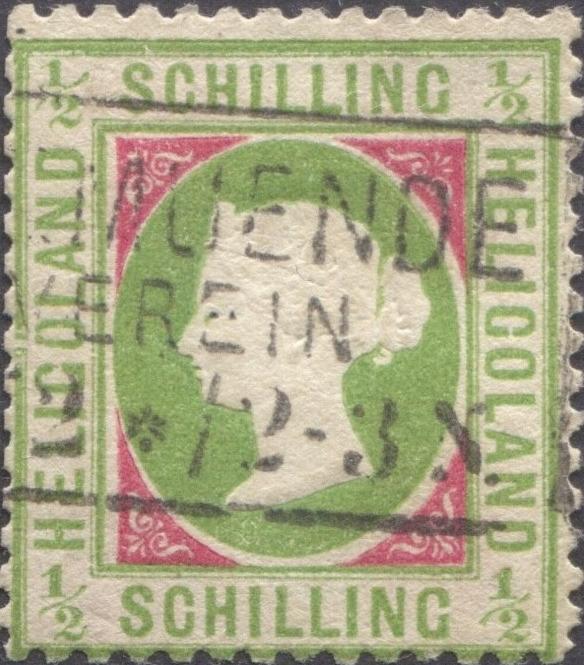



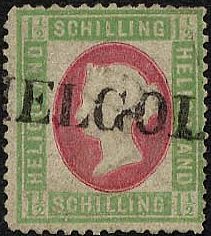

Many reprints exist, the stamps above are probably genuine
1/4 Schilling green and red (only perforated) 1/4 Schilling red and green (only perforated) 1/2 Schilling green and red 3/4 Schilling green and red (only perforated) 1 Schilling green and red 1 1/2 Schilling green and red (only perforated) 2 Schilling green and red (only rouletted) 6 Schilling green and red (only rouletted)
For the specialist: Genuine perforated stamps have perforation 13 1/2 x 14 1/2 (but some reprints also). The 1/2 Sch rouletted exists in two types (differing in the curl behind the Queen's head).
Value of the stamps |
|||
vc = very common c = common * = not so common ** = uncommon |
*** = very uncommon R = rare RR = very rare RRR = extremely rare |
||
| Value | Unused | Used | Remarks |
| Rouletted | |||
| 1/2 s | RR | RR | Specialists distinguish two types of the head |
| 1 s | R | R | |
| 2 s | * | *** | Exists with higher 'SC' |
| 6 s | * | R | |
| Perforated | |||
| 1/4 s red and green | ** | RR | |
| 1/4 s green and red | *** | RR | |
| 1/2 s | *** | *** | |
| 3/4 s | * | RR | |
| 1 s | *** | R | |
| 1 1/2 s | *** | R | |
| 2 s and 6 s with perforation are reprints |
c | ||
| Reprints | |||
| All values | c | - | |
With cancel "Aus Helgoland uber Cuxhaven":


"GEESTEMUENDE ZOLLVEREIN" cancel.
The reprints have been made in Berlin (1875, 1879 and 1884, Leipzig (1888, by the printer Giesecke & Devrient) and Hamburg (1891, 1892 and 1895 at the firm Schlotke & Co.). The Hamburg reprints are perforated 14. Rouletted reprints also exist. The Berlin reprints were made by the stamp dealer Julius Goldner of Hamburg, he received the original plates from the 'Reichdruckerei' (source: 'Distinghuishing Characteristics of Classic Stamps Europe 19th Century, Except Old German States' by Herman Schloss). Other sources say that Goldner was also heavily involved in the Leipzig and Hamburg reprints. Of the Berlin reprints alone 1680000 copies were made (source http://www.fritzwagner.com/helgoland/robert_pollard_heligoland.html). At least double this amount was reprinted in Leipzig and Hamburg (same source). More specific information on reprints can also be found on the above mentioned website.
The 2 Sch and 6 Sch were only issued rouletted, therefore perforated stamps, that can often be found of these two values, must be reprints, example:

(Example of a reprint)
Some 'errors' of the Hamburg reprint, a missing red colour imperforate stamp, an imperforate stamp, and the center part upside down:
The Berlin reprints also exist imperforate, example:
The reprints even exist in black colour only, example of a 1/2 sch:
A forged cancel (on reprints?):

Since most of these stamps are worth much more cancelled than uncancelled, many forged cancels have been applied. Even the signatures of experts have been forged on stamps with forged cancels (see http://www.qn.net/~fjw/helgoland/helgoland_forgeries.html for examples).
I think the next stamp is a forgery, note the small dividing line in the '1/2' compared to a genuine stamp.

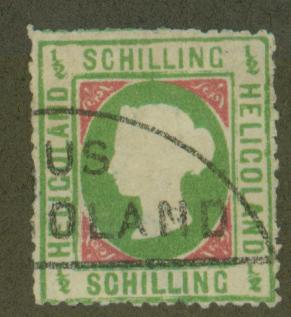


(Probably forgeries, the cancels read "AUS HELGOLAND")

The same forgery of the 1/2 Sch value, note that the
"/" of the "1/2" are too short. Also note the
typical shape of the lower hairbun.
On the website http://www.qn.net/~fjw/helgoland/helgoland_forgeries.html, two more forgeries can be found of the values 3/4 Sch and 6 Sch, it seems that the head of the Queen is not embossed on these forgeries.
I've been told that the next stamps are also forgeries:
Forgeries exist, but are relatively rare compared to reprints.
The forger Fournier also sold forgeries of this issue. The next image shows two cancels that were apparently used by him on these forgeries (taken from a 'Fournier Album of Philatelic Forgeries'):

Fournier forged cancels

Page from a Fournier Album with forgeries and forged cancels.

Another set of forgeries from a Fournier Album
1 Pfennig (=1 Farthing) green and red 2 Pfennig (=2 Farthing) green and red 5 Pfennig (=3 Farthing) green and red 10 Pfennig (=1 1/2 Pence) green and red 25 Pfennig (=3 Pence) green and red 50 Pfennig (=6 Pence) green and red
Genuine stamps have perforation 13 1/2 x 14 1/2. The 1 p and 2 p have been reprinted. No reprint of the other values exist (except for some German government reprints in 1890; a few hundred only).
Value of the stamps |
|||
vc = very common c = common * = not so common ** = uncommon |
*** = very uncommon R = rare RR = very rare RRR = extremely rare |
||
| Value | Unused | Used | Remarks |
| 1 p | * | R | Reprint: c |
| 2 p | * | RR | Reprint: c |
| 5 p | * | *** | |
| 10 p | * | *** | |
| 25 p | * | *** | |
| 50 p | ** | *** | |

(Inverted middle part, probably a reprint)

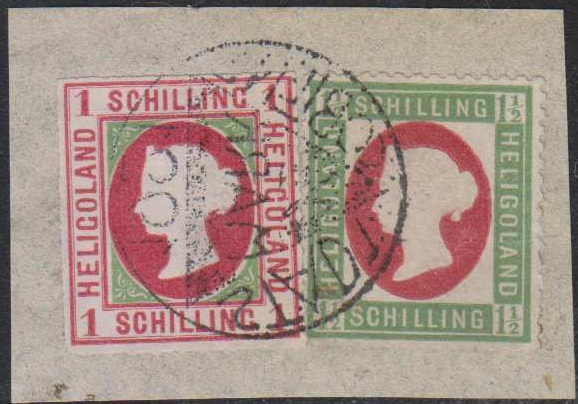
Most likely reprints with forged cancels.
3 Pfennig (=2 1/2 Farthing) green,red and yellow 20 Pfennig (=2 1/2 Pence) green, red, yellow and black
These stamps are perforated 13 1/2 x 14 1/2. They were printed in sheets of 10. The 3 p has been reprinted in Berlin (1880 and 1885) and Hamburg (1891 and 1892, both perforated 14). All 3 p stamps with line perforation are reprints (the perforation does not match in the corners in those reprints). The 20 p has not been reprinted (except for 200 reprints made by the German government in 1890).
Value of the stamps |
|||
vc = very common c = common * = not so common ** = uncommon |
*** = very uncommon R = rare RR = very rare RRR = extremely rare |
||
| Value | Unused | Used | Remarks |
| 3 p | *** | RR | Reprint: c |
| 20 p | * | *** | |
1 Mark (=1 Shilling) green, red and black 5 Mark (=5 Shilling) green ,red, yellow and black
These stamps are perforated 13 1/2 x 14 1/2, they also exist non-issued in perforation 11 1/2 (proofs). Reprints do not seem to exist (except for a very limited government reprint).
Value of the stamps |
|||
vc = very common c = common * = not so common ** = uncommon |
*** = very uncommon R = rare RR = very rare RRR = extremely rare |
||
| Value | Unused | Used | Remarks |
| 1 M | *** | R | |
| 5 M | R | RR | |
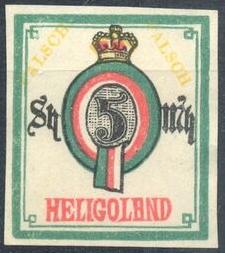
A Senf forgery, with the words
"FALSCH" printed twice in yellow on top.
10 Pfennig (=1 1/2 Pence) red "20 PFENNIG 2 1/2 PENCE" on 10 Pfennig red
5 Pfennig (=3 Farthings) green "10 Pfennig/1 1/2 Pence" on 5 Pfennig green
Deceptive forgeries of the 5 p cards exist. Fortunately the size is different: the forged cards are 89 mm high while the genuine ones are 91 mm high. A picture of a forged card can be found at: http://briefmarken.ag./.
Some forgeries are mentioned in the Philatelic Record of 1891 (page 32), of 3 farthings (5 pfennig) reply postcards, green with black border. The front has an erroneous inscription 'reserve' instead of 'reverse'.

(Postcard with arms of Heligoland, 10 p black)
10 p black

(Certified genuine)

(Reduced sizes, probably reprints)
3 p (2 farthings) green 5 p (3 farthings) red 10 p (1 1/2 pence) blue
The stamp dealer Goldner of Hamburg obtained the plates of the 3 p wrapper. He changed this into a 5 and 10 p value. These were then sold as reprints. I presume the above shown stamps are those reprints. Source: 'Philatelic Forgers Their Lives and Works' by Varro E. Tyler.
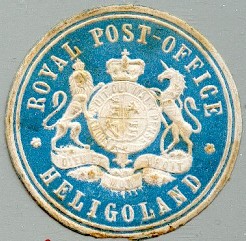
(Seal of Heligoland, inscription "ROYAL POST-OFFICE
HELIGOLAND" with arms of Great Britain)
Briefmarken - Timbres-Poste - Stamps - Postzegels